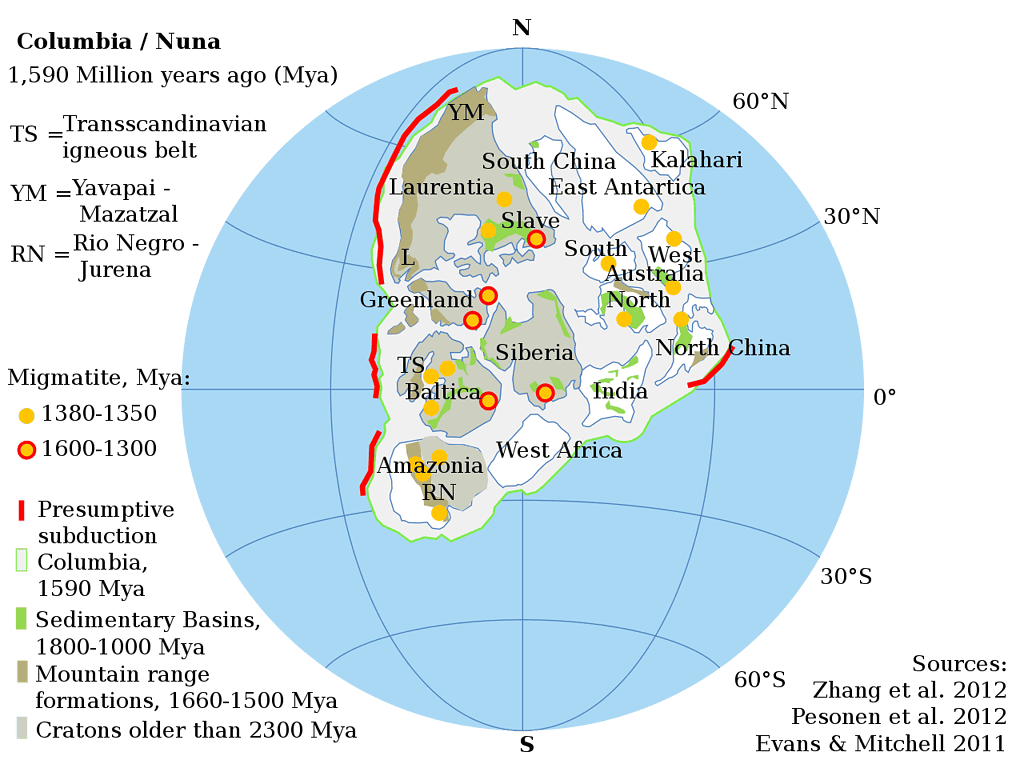 Credit: Unsplash/Javier Miranda.
Credit: Unsplash/Javier Miranda.
From 1.8 billion to 800 million years ago, Earth was seemingly quite a boring place. Continents moved little, and life evolved excruciatingly slowly. Not much seemed to be going on, which is why you’ll sometimes hear this stretch of time called the Boring Billion.
But a new study, drawing on an ambitious reconstruction of plate tectonics across nearly two billion years, suggests that the breakup of the ancient supercontinent Nuna (also known as Columbia) sent ripples through the planet’s climate and chemistry. Those changes opened the door for complex life to take hold. The research, published in Earth and Planetary Science Letters, offers the most detailed picture yet of how tectonics, carbon cycling, and biology became intertwined during one of Earth’s least understood eras.
“The term was coined to describe what appeared to be a long interval of geochemical, climatic, and biological stability in Earth’s history,” Dietmar Müller, a geophysicist at the University of Sydney and lead author of the study, told Live Science. “However, we now know that this interval was less boring in terms of plate tectonics and evolutionary changes than previously thought.”
His team’s findings show just how dramatic that period truly was.
The Great Fracturing
The story begins around 1.46 billion years ago when Nuna, Earth’s first supercontinent, began to fracture. As its pieces drifted apart and the gaps widened, long, shallow seas formed along the stretching continental margins. These seas, temperate and oxygen-rich, likely became cradles for new forms of life.
“We think these vast continental shelves and shallow seas were crucial ecological incubators,” said study co-author Juraj Farkaš in a statement. “They provided tectonically and geochemically stable marine environments with presumably elevated levels of nutrients and oxygen, which in turn were critical for more complex lifeforms to evolve and diversify on our planet.”
The researchers’ simulations reveal that these continental shelves expanded dramatically. Over roughly 350 million years, the total length of shallow margins doubled, reaching about 130,000 kilometers—more than three times the circumference of Earth’s equator.
This explosion of shallow-water real estate coincided with one of the most significant evolutionary milestones in history: the rise of eukaryotes, organisms whose cells contain internal compartments and a nucleus. All plants, animals, fungi—and yes, even humans—trace their ancestry to those early pioneers.
Fossils show that crown-group eukaryotes appeared around 1.05 billion years ago. Müller and his colleagues noticed that this emergence occurred precisely when passive continental margins reached their greatest extent. In other words, complex life began to flourish during the peak of tectonic fragmentation.
But something else was also shifting beneath them.
 Estimated configuration of the supercontinent Nuna. Credit: Wikimedia Commons
Estimated configuration of the supercontinent Nuna. Credit: Wikimedia Commons
Cooling Into Habitability
As Nuna broke apart, subduction zones, where one tectonic plate sinks beneath another, shortened globally. Volcanoes are fed by these zones, and they act as one of the planet’s major sources of carbon dioxide.
With shorter subduction zones, less CO₂ escaped into the atmosphere. Müller’s team found that volcanic outgassing more than halved between 1.75 billion and 1.27 billion years ago. Simulations show CO₂ emissions falling from about 30 megatons per year to roughly 10 megatons annually.
“This dual effect—reduced volcanic carbon release and enhanced geological carbon storage—cooled Earth’s climate and altered ocean chemistry, creating conditions suitable for the evolution of more complex life,” said study co-author Adriana Dutkiewicz.
Another factor that helped cool the planet was the formation of new ocean crust. As seawater seeped into the new seafloor’s cracks, it reacted with the rocks and trapped carbon in solid minerals. This process took extra CO₂ out of the atmosphere, further cooling the planet.
Together, these changes led to a cooler planet. The once stagnant oceans began to take on more oxygen, but not everywhere—just in the shallow areas where sunlight and chemistry could work together. These shallow seas became oxygen oases.
Other studies have identified similar redox shifts in ancient oceans. Geochemical signals, including enrichments of molybdenum and uranium, along with changes in sulfur and chromium isotopes, suggest that oxygen levels fluctuated in the oceans around 1.1 billion years ago. Müller’s reconstructions provide a tectonic explanation for these shifts.
Thus, life found a way.
Why This Research Matters Now
This study tackles a long-standing question: How much did plate tectonics influence the rise of complex life?
In more recent eras, scientists know that the breakup of continents has spurred bursts of biodiversity by creating shallow seas and isolated habitats. But the Proterozoic Eon (Earth’s “middle age”) has been far murkier. Geological records from that time are sparse. Passive margins from this time are rarely found in the geological record. This led many scientists to believe that continents were mostly stable and life wasn’t changing much.
This study challenges that assumption head-on.
 3D reconstruction of the mysterious Proterozoic organism Diskagma buttonii. Credit: Wikimedia Commons
3D reconstruction of the mysterious Proterozoic organism Diskagma buttonii. Credit: Wikimedia Commons
By reconstructing 1.8 billion years of plate boundaries, seafloor ages, and carbon reservoirs, Müller’s team ties together a story spanning tectonics, climate, and evolution. It suggests that the rise of eukaryotes was not an isolated biological event. Instead, it emerged from a cascade of geological shifts that reshaped Earth’s surface.
Their research also helps climate modelers address the faint young Sun paradox—how Earth stayed ice-free despite a weaker Sun. Paleosol data show that atmospheric CO₂ levels dropped from very high early in the Proterozoic to only a few times the levels we see today by 1.1 billion years ago.
In the end, the so-called Boring Billion looks less like a stagnant plateau and more like the slow, deliberate preparation of a stage.
“The next steps will be to discover more well-preserved eukaryote fossils to document their earliest evolution,” Müller concluded.

